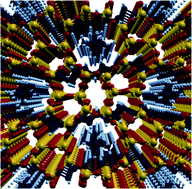Binding is responsible for exceptional hardness in polyethylene/silicalite nanocomposite materials†
Abstract
Polyethylene/silicalite nanocomposites potentially represent a class of materials with extremely interesting mechanical properties. However, in order to outline a strategy for controlling their properties, a deep understanding of the physical phenomena taking place at an atomistic scale is required. Ab initio quantum mechanical simulations presented in this work show that by increasing or decreasing the binding energy between the two moieties, the hardness of the material can be tuned at will. Moreover, residual internal stresses after synthesis significantly deteriorate the mechanical properties, and a way to release them must be found.


 Please wait while we load your content...
Please wait while we load your content...